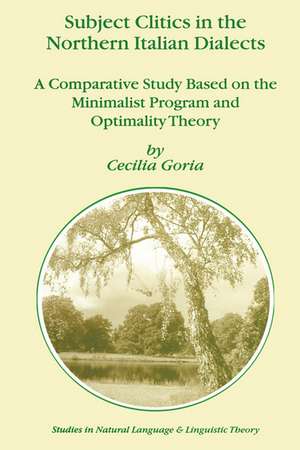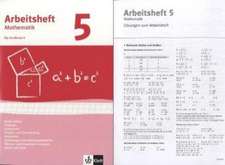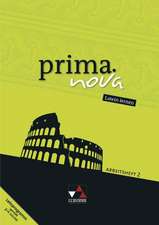Subject Clitics in the Northern Italian Dialects: A Comparative Study Based on the Minimalist Program and Optimality Theory: Studies in Natural Language and Linguistic Theory, cartea 60
Autor Cecilia Goriaen Limba Engleză Hardback – 13 oct 2004
| Toate formatele și edițiile | Preț | Express |
|---|---|---|
| Paperback (1) | 640.55 lei 6-8 săpt. | |
| SPRINGER NETHERLANDS – 13 oct 2004 | 640.55 lei 6-8 săpt. | |
| Hardback (1) | 646.75 lei 6-8 săpt. | |
| SPRINGER NETHERLANDS – 13 oct 2004 | 646.75 lei 6-8 săpt. |
Din seria Studies in Natural Language and Linguistic Theory
- 24%
 Preț: 808.03 lei
Preț: 808.03 lei - 18%
 Preț: 788.72 lei
Preț: 788.72 lei - 18%
 Preț: 958.56 lei
Preț: 958.56 lei - 15%
 Preț: 600.26 lei
Preț: 600.26 lei - 18%
 Preț: 947.67 lei
Preț: 947.67 lei - 15%
 Preț: 646.62 lei
Preț: 646.62 lei - 18%
 Preț: 723.56 lei
Preț: 723.56 lei - 15%
 Preț: 604.84 lei
Preț: 604.84 lei - 18%
 Preț: 952.09 lei
Preț: 952.09 lei - 15%
 Preț: 642.51 lei
Preț: 642.51 lei - 18%
 Preț: 947.50 lei
Preț: 947.50 lei - 15%
 Preț: 646.75 lei
Preț: 646.75 lei - 18%
 Preț: 1224.54 lei
Preț: 1224.54 lei - 15%
 Preț: 641.71 lei
Preț: 641.71 lei - 18%
 Preț: 2314.56 lei
Preț: 2314.56 lei - 18%
 Preț: 952.89 lei
Preț: 952.89 lei - 18%
 Preț: 1220.12 lei
Preț: 1220.12 lei - 15%
 Preț: 642.83 lei
Preț: 642.83 lei - 18%
 Preț: 944.19 lei
Preț: 944.19 lei - 15%
 Preț: 648.05 lei
Preț: 648.05 lei - 18%
 Preț: 952.57 lei
Preț: 952.57 lei - 18%
 Preț: 1729.61 lei
Preț: 1729.61 lei - 15%
 Preț: 644.95 lei
Preț: 644.95 lei - 15%
 Preț: 644.63 lei
Preț: 644.63 lei -
 Preț: 384.48 lei
Preț: 384.48 lei - 18%
 Preț: 1662.85 lei
Preț: 1662.85 lei - 18%
 Preț: 955.08 lei
Preț: 955.08 lei - 18%
 Preț: 952.40 lei
Preț: 952.40 lei -
 Preț: 386.81 lei
Preț: 386.81 lei
Preț: 646.75 lei
Preț vechi: 760.88 lei
-15% Nou
Puncte Express: 970
Preț estimativ în valută:
123.75€ • 129.21$ • 102.42£
123.75€ • 129.21$ • 102.42£
Carte tipărită la comandă
Livrare economică 05-19 aprilie
Preluare comenzi: 021 569.72.76
Specificații
ISBN-13: 9781402027369
ISBN-10: 1402027362
Pagini: 300
Ilustrații: X, 288 p.
Dimensiuni: 155 x 235 x 22 mm
Greutate: 0.59 kg
Ediția:2004
Editura: SPRINGER NETHERLANDS
Colecția Springer
Seria Studies in Natural Language and Linguistic Theory
Locul publicării:Dordrecht, Netherlands
ISBN-10: 1402027362
Pagini: 300
Ilustrații: X, 288 p.
Dimensiuni: 155 x 235 x 22 mm
Greutate: 0.59 kg
Ediția:2004
Editura: SPRINGER NETHERLANDS
Colecția Springer
Seria Studies in Natural Language and Linguistic Theory
Locul publicării:Dordrecht, Netherlands
Public țintă
ResearchCuprins
1 Introduction.- 1.0 Introduction.- 2.0 The Dialect.- 3.0 The object of inquiry.- 4.0 Objectives and proposals.- 5.0 Theoretical background.- 5.1 The Minimalist Program.- 5.2 Optimality Theory.- 6.0 This study: questions and answers.- 6.1 What is the empirical and theoretical significance of working with SCLs in Piedmontese?.- 6.2 Why is a twofold approach adopted and what are the benefits of this choice?.- 6.3 What are the boundaries of each approach in the analysis proposed in this book?.- 7.0 The Data.- 8.0 Organisation.- Notes.- 2 The Data.- 1.0 Introduction.- 2.0 Turinese.- 2.1 Turinese SCLs and types of subjects and verbs.- 2.2 Linear order between SCLs and other proclitics.- 2.3 SCLs and negative markers.- 2.4 Direct interrogatives.- 2.5 SCLs in subordinate clauses.- 2.6 SCLs in coordinated clauses.- 2.7 SCL: Non-finite forms and true imperatives.- 2.8 Optionality.- 3.0 Astigiano.- Notes.- 3 Optimal Agreement The position and the function of SCLs.- 1.0 Introduction.- 2.0 The proposal.- 3.0 Pre verbal subjects.- 3.1 Arguments against the left dislocation analysis of unmarked preverbal subjects in Italian and the NIDs.- 3.2 Subject-in-CP analysis (Poletto 2000b).- 3.3 Subject positions below the CP boundary: more evidence for SCLs in T.- 4.0 The Extended Projection Principle.- 4.1 SCLs and the EPP.- 5.0 A multi-layered model for SCLs: an overview.- 5.1 Four types of SCLs: an outline of Poletto’s Agreement Field.- 5.2 The Agreement Field.- 5.3 Reviewing the Agreement Field: Turinese and Astigiano.- 6.0 Conclusion.- Notes.- Chapter4 Optimal Agreement The morphology and the distribution of SCLs.- 1.0 Introduction.- 2.0 Optimal Agreement.- 3.0 The feature specification of Piedmontese SCLs.- 3.1 The Basic System and the Deictic Systems.- 3.2 Full and PersonOptionality.- 3.3 SCLs in coordination.- 4.0 Summary and conclusion.- Notes.- 5 Beyond Piedmontese.- 1.0 Introduction.- 2.0 Beyond Piedmontese and the minimalist component of Optimal Agreement.- 2.1 Negation.- 3.0 A common property across the NIDs and SCL types.- 3.1 Imperatives.- 3.2 Non-finite verb forms.- 4.0 Beyond Piedmontese and the OT component of Optimal Agreement.- 4.1 Renzi and Vanelli’s (1983) SCL Systems and Florentine.- 5.0 Illegitimate candidates.- 5.1 Candidates that do not encode [±add,sg].- 5.2 Two feature combination constraints.- 5.3 An alternative analysis: [?] Dominance Scale.- 6.0 Conclusion.- Notes.- 6 Beyond SCLs: Piedmontese interrogatives.- 1.0 Introduction.- 2.0 Interrogative inversion and ICLs.- 2.1 ICLs as interrogative morphology.- 2.2 Agreement constraints and ICLs.- 3.0 A unitary account of Piedmontese interrogation strategies.- 3.1 Wh+che questions.- 3.2 Theproposal.- 4.0 Summary.- 5.0 Interrogativity and the Agreement Field (Poletto 2000b).- 5.1 Piedmontese.- 6.0 Conclusion.- Notes.- 7 Concluding remarks.- 1.0 A summary of Optimal Agreement and its achievements.- 2.0 Contribution to structure-minimality.- 3.0 Structure-minimality vs. amyriad of projections.- 4.0 Topics for future study.- 4.1 A gradual notion of Finiteness: what do SCLs teil us?.- 4.2 OT in narrow syntax.- Notes.- References.











